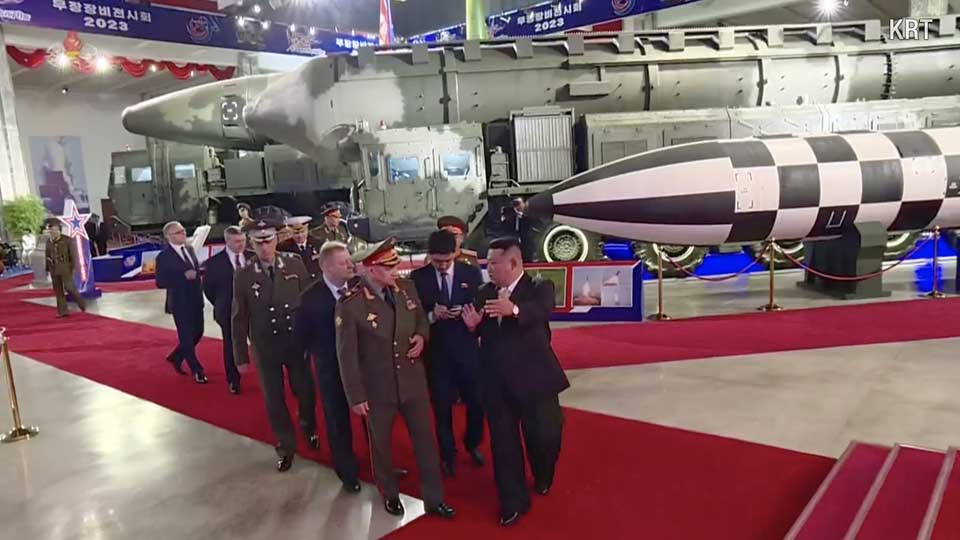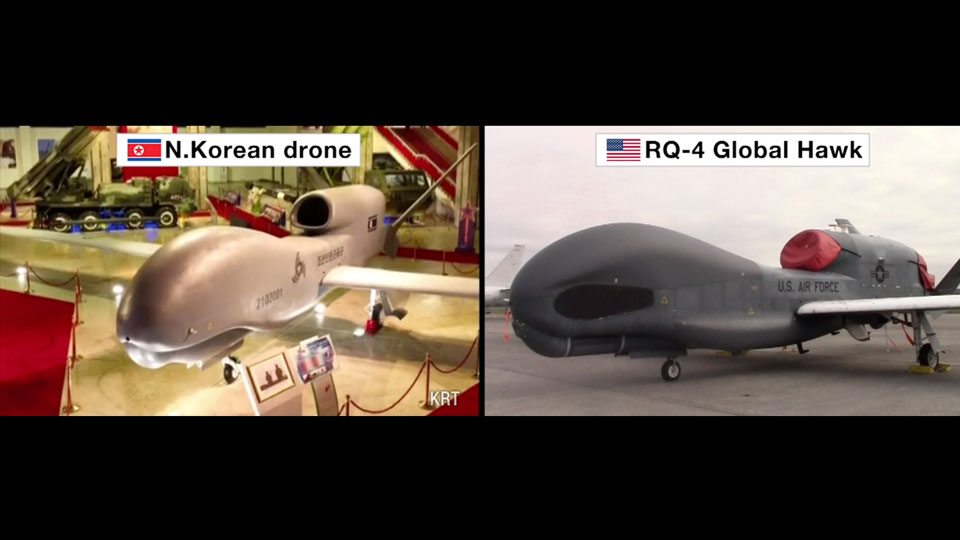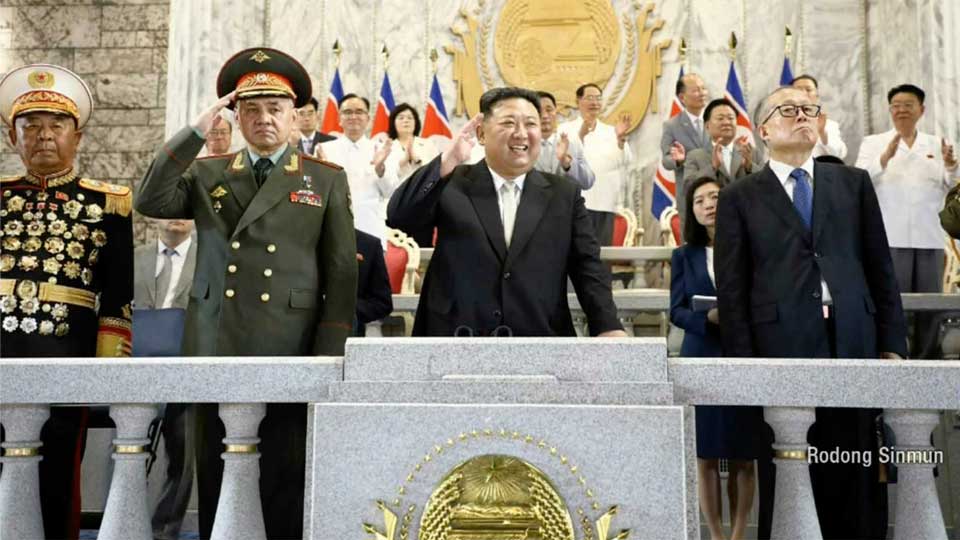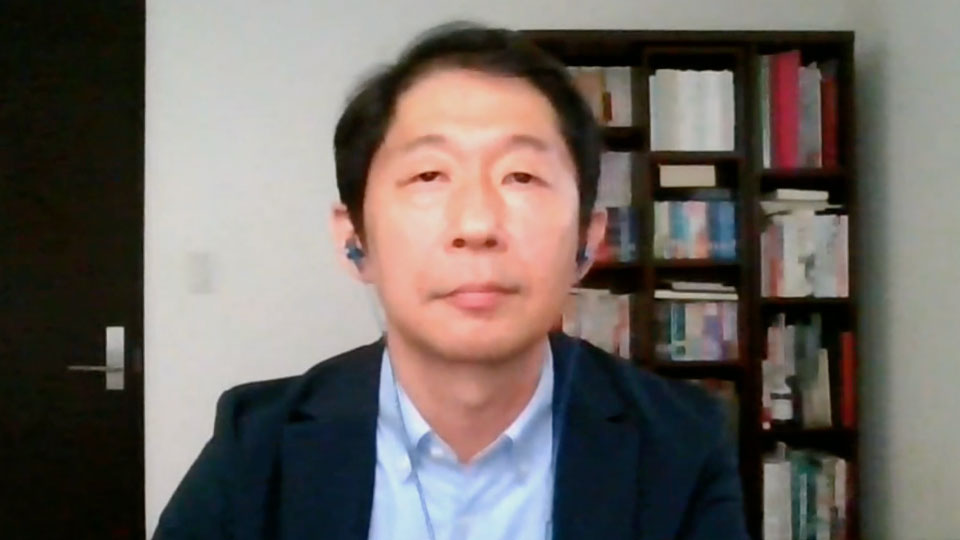The Friday edition of North Korea's ruling Workers' Party newspaper, Rodong Sinmun, reported the parade was held at a square in central Pyongyang on Thursday night.
A picture on the front page showed Kim on a balcony flanked by Sergei Shoigu, the Russian defense minister, and Li Hongzhong, the vice chairperson of the Standing Committee of China's National People's Congress.
The parade — the first since February — featured North Korea's latest intercontinental ballistic missiles, the Hwasong-18 and the Hwasong-17.
Pyongyang test-fired the Hwasong-18, a solid-fuel ICBM, for the second time on July 12. The article described the missiles as the country's strongest strategic weapons.
The parade also featured a flyover of new spy and attack drones.
North Korean defense minister Kang Sun Nam stressed the rivalry with the United States in his speech.
Kim did not deliver a speech at the parade.
North uses parades to demonstrate military power
North Korea often uses large-scale parades to show off its latest military hardware.
In October 2020, the country held a parade to mark the 75th anniversary of the foundation of the ruling Workers' Party. It used the occasion to unveil the Hwasong-17, a liquid fuel-type intercontinental ballistic missile mounted on a 22-wheel mobile launch pad. The missile is said to be capable of reaching anywhere in the US.
Another missile, the Pukguksong-4, was unveiled at the same parade. The Pukguksong-5 was displayed at a parade in January 2021. They are believed to be new types of submarine-launched ballistic missiles, or SLBM.
And at a parade this February celebrating the 75th anniversary of the establishment of the military, the country showed off the fruits of its rapid missile development. A new Hwasong-18 was displayed alongside more than ten Hwasong-17s. The military says it is a new type of solid-fuel ICBM class missile that can be launched faster than liquid fuel models. It was mounted on an 18-wheel mobile launch pad.
This parade was also notable for the presence of leader Kim Jong Un's daughter. It was her first appearance at a military parade.
North shows solidarity with Russia
Prior to Thursday's parade, state-run Korean Central Television aired footage of Kim Jong Un accompanying Russian defense minister Sergei Shoigu at an arms exhibition in Pyongyang.

The video showed the Hwasong-18 and what is believed to be a newly developed large drone.
The Kremlin posted an announcement attributed to President Vladimir Putin. It expressed appreciation for the "strong support from North Korea for the special military operation in Ukraine and solidarity with Russia to oppose the policy of the collective West, which prevents the establishment of a truly multipolar, just world order."
Analysis: North aims to show off strong ties with Russia, China
NHK's former Seoul bureau chief Ikehata Shuhei says the parade is part of a very clear message North Korea is sending to the West. He says the country wants to show off the extent of its practical military capabilities:
"Obviously, North Korea is very fond of staging these kinds of military parades. They do it all the time. It's always an opportunity to show off new hardware. This time, just ahead of the parade, we saw what appear to be copies of two US military drones. One resembles the MQ-9 Reaper, which is capable of carrying out air strikes. The other drone looked like the RQ-4 Global Hawk. It's an unarmed reconnaissance drone. During the parade broadcast, North Korean television showed pre-recorded video appearing to show the drones in flight, and one of them launching missiles."

"Unmanned aircraft have been a game-changer in modern conflicts. By showing off these designs, Pyongyang is saying that they are not just relying on ballistic missiles and they can fight a war with the same — or similar — tools to that of the US or South Korean militaries."
Ikehata also says the presence of dignitaries from Russia and China was notable.
"This parade marked the 70th anniversary of the Korean War Armistice, which the North insists was a 'victory' over the UN forces led by the US. The former Soviet Union, and especially China, were essential supporters for Pyongyang during that fight. But recently, there's been a bit of a reversal for Moscow. North Korea has actually supplied Russia with weapons, like artillery shells, for its ongoing invasion of Ukraine. Russian Defense Minister Sergei Shoigu may not have just been visiting out of solidarity. He and Kim Jong-Un may have been discussing their next arms deal."

"I'm sure Kim was pleased he could show the West his regime has strong support from two world powers. It's also the first major visit by foreign delegations since the COVID-19 pandemic, so this also sends a message of internal recovery to the North Korean public."
But Ikehata says it's unclear whether North Korea will continue its aggressive behavior moving forward, or quickly change course.
"It will have long stretches where it will threaten its neighbors and conduct missile launches. But then, suddenly, they say they're open for talks. We've seen a record number of ballistic missile tests in the last two years, including the new Hwasong-18, which is believed to have the range to hit anywhere in the US. At the same time, we've seen some signs Pyongyang could be open to restarting diplomacy with Japan. Given North Korea's track record, the US and its allies should be prepared for another change in tactics."
